In this review, we take a look at the Laowa 10mm F2.8 Zero-D autofocus for Sony FE-mount.

Introduction
Laowa has become, over recent years, a well-regarded name in photography. Concentrating on macro and ultra-wide lenses, the company has made a name for itself with excellent value, robust and elegant lens bodies, superb control of distortion (a key aspect for wide lenses) and reasonable prices. We have reviewed several of their lenses in the past, among which the 10-18mm F4.5/F5.6, 12-24mm F5.6 and 15mm F2, all examples of wide angle lenses.
The only true limitation of Laowa lenses, until now, was that all their lenses were purely manual, both for focusing and exposure. Regarding the latter, it is easily mitigated, since the camera operates in an equivalent to A mode with the aperture controlled via the lens. Focus is another matter. It is perfectly feasible to focus manually, especially using focus peaking, and Laowa lenses traditionally offer excellent focus rings with high accuracy. Still, for some users there is no substitute to autofocus, especially given Sony’s emphasis on this aspect.
Laowa’s newest lens thus generated quite a splash when it was introduced: a fully automatic lens with a resolutely modern look while still keeping the company’s optical design priorities. The lens is 10mm with a fast aperture of F2.8. It bears the brand’s “zero-D” label, hinting at top-of-the-line control over distortion.
The company’s previous offerings close to this focal length have often been zooms, with the compromises this implies. Their primes generally perform better, and Laowa’s F2.8 lenses historically have been very good. A 10mm F2.8 lens is ambitious, even without considering that it is the manufacturer’s first AF lens. As such, this lens has a lot to live up to!
In this in-depth review, we will take a look at all the technical and artistic parameters which help to define a lens. Read on to find out everything there is to know about the Laowa 10mm F2.8 Zero-D AF!
Table of Contents[Hide][Show]
Specifications
| Lens Name | Laowa 10mm F2.8 Zero-D FF |
| Optical formula | 15 elements in 9 groups |
| Image circle | Full frame |
| Field of view diagonal | FF: 130.4° APS-C: 109.2° |
| Aperture range | F2.8/F22 |
| Aperture blades | 5, straight (14-blades, manual focus variant can be ordered) |
| Aperture ring | No |
| Max magnification | 0.24X |
| Minimum focus distance | 0.12m |
| Internal focus | Yes |
| Filter thread diameter | 77mm |
| Lens cap | Plastic, clip-on |
| Lens hood | Built-in petal-shaped |
| Diameter x Length | 82 x 70.8 mm (3.2 x 2.8 in) |
| Weight | 420 g (14.8 oz) |
| Price (US MSRP) | $799 |
Construction and Handling
In this section, we take a look at the physical characteristics of the Laowa 10mm.
Front Element

The front of the lens bears the branding, which is a mouthful. The glass takes up a rather small part of the total front surface.
The lens uses a large 77mm filter thread. Larger filters are of course more expensive, and 77mm is rarer than smaller diameters, but it is surprising and positive to see such a wide lens capable of using regular filters.
The lens cap is plastic.
Lens Body

The lens is quite a departure from what Laowa usually produces. Their lenses historically have shown a utilitarian, vintage look with a smooth black metal body and elegant engraving. This lens looks good and resolutely modern, and like nothing Laowa ever produced before. Some of its design cues are somewhat reminiscent of Irix lenses and are certainly different than most FE-mount lenses.
The Laowa 10mm AF has a blue-gray metal finish that’s truly unique. The color seems to change depending on the ambiant light. The lens feels rugged and durable, and it is even weather-sealed, another first for Laowa. It is lightweight given its size, at 420g.
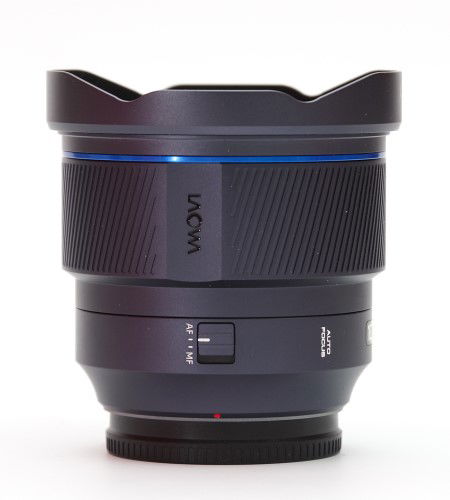
The bottom of the body shows an alignment dot for mounting. The lens flares out from the mount towards the main body. The bottom part of the main body bears the (simplified) lens name at the front, close to an “Auto Focus” label. On the right side is the Laowa name, and on the left side is an AF-MF switch. Laowa wanted to make it obvious that this is an AF lens.

The main part of the lens body is taken up by the wide focus ring. As with all AF E-mount lenses, it focuses by wire. The ring still offers excellent feedback and dampening, keeping in line with MF Laowa lenses and doing better than many other manufacturers’ AF products. This ring is easy to grip and operate. It has diagonal depressions, and two mostly flatter surfaces with the Laowa name engraved.
Towards the top is the company’s signature blue ring, and the permanently attached slim lens hood.
The lens does not extend when zooming.
Aperture
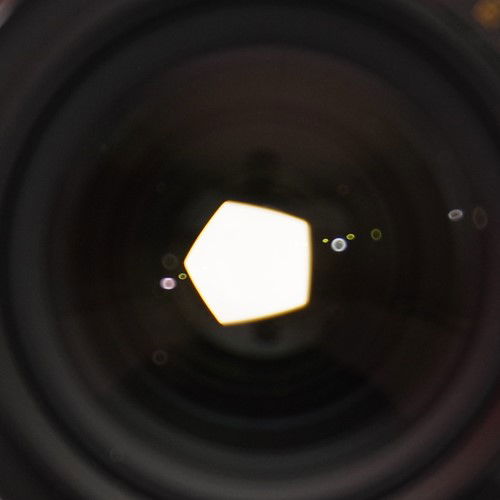
The Laowa 10mm uses 5 straight aperture blades. Bokeh isn’t a key aspect for an ultra-wide lens, so this shouldn’t be an issue, and it should help with starbursts. The company offers the option to order a 14-blades, fully manual version of the lens.
Lens Mount

The lens mount is metal, and features a gray o-ring to protect against water ingress.
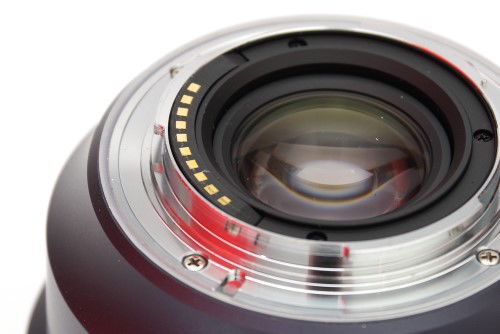
Lens hood
The lens ships with a permanently attached lens hood. It is petal-shaped and slim.

Mounted On Camera
The Laowa 10mm F2.8 feels right at home on a small body like the A7C. It balances nicely and is easy to operate. The unique color of the lens is obvious on these images. In person, it does not look out of place.


Side by side
Here is the Laowa 10mm next to the Tamron 28-75mm F2.8 and Tamron 20mm F2.8. The Laowa is close in size to the 20mm, especially when taking into account its permanent hood.
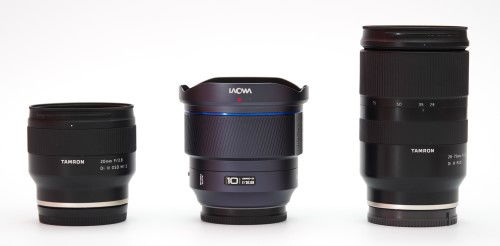
This second image shows the front elements of the Tamron 20mm and Laowa 10mm, to highlight the impact of the 77mm diameter compared to the Tamron’s 67mm.
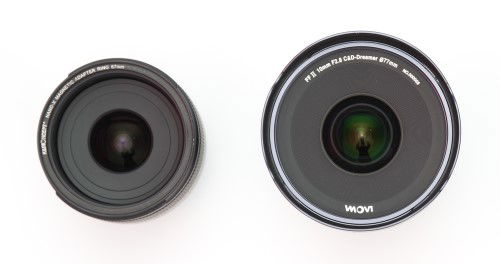
Focusing
The Laowa 10mm is the company’s first AF lens, but it doesn’t show. This lens feels similar to any AF lens from any manufacturer. We get the impression that Laowa has been doing AF lenses forever.
In general use, the lens feels extremely responsive and reliable. It never struggles to lock focus, and adjustments are nearly instant. The lens is also perfectly silent, doing better in this regard than, say, Tamron’s trio of compact primes. An ultra-wide lens benefits from a deeper DOF, which helps to quickly lock focus, but in truth this does not feel like a first attempt, but rather like a full-fledged and serious product.
There is an AF-MF switch on the left side, a welcome feature. This lens, like other E-mount lenses, uses focus-by-wire, meaning the focus ring tells the camera that it should move the focus motor. With focus-by-wire, there can be a slight lag, as well as a lifeless feel when compared with a mechanical focus lens. Laowa has a strong history of making MF lenses with pleasant and accurate focus rings. Some of this translates here. The 10mm has an excellent focus ring, with good dampening and feedback. Other manufacturers could have a look and learn a few things. Like other focus-by-wire lenses, the speed of rotation of the ring determines the speed of the adjustments. Turning slowly gives precise control, turning fast allows for coarse adjustments.
We observed no occurrences of hunting during our tests. Focus was accurate and dependable in all cases.
AF Speed
AF speed was tested with the A7C. The subject was a black cross on a white background, about 1.5 meters in front of the camera. We used the central focus point. Three measurements were averaged for each data point.
For reference, 5 EV corresponds roughly to a small room lit with a 60 W bulb, a sunny day corresponds to 16 EV, and a moonlit night to -2 EV.

As is often the case with E-mount lenses, focus speeds at very low light levels (close to -2 EV) are rather slow. There is nothing wrong here but at around 1.3 seconds to lock focus, the speed is not amazing.
Increase light levels even a little and the lens becomes blazing fast. Even around -0.3 EV, focus locks in 0.6 seconds, and better light brings speeds of about 0.3 seconds, nearly instant.
In summary, Laowa’s first AF lens produces excellent focus speeds and its manual focus capabilities are also very good, better than many other competitors.
AF Tracking
AF tracking, or continuous AF, is a hallmark of Sony cameras. As such, it is important to evaluate whether or not the Laowa 10mm can keep up with fast movements of the subject.
In our experience, the lens performs admirably in this regards. Wide angle lenses are not used often with moving subjects but when it had to, the lens never struggled.
The following animation shows a series of 23 images, and involves movement diagonal to the photographer and a rotation of the camera. All images remained well focused. Moreover, the AF was initiated after the subject started moving.

General Image Quality
Before diving into the technical aspects of this review, let’s have a look at the more subjective elements which can make or break an image.
Field of View
10mm is deep into ultra-wide territory. Going from the common 28mm to, say, 20mm doesn’t present a big paradigm shift. Moving to 10mm however is truly different.
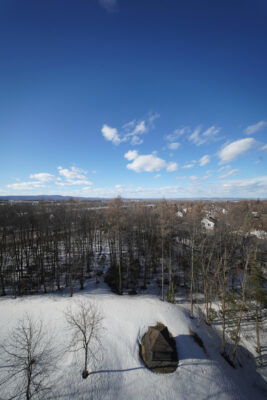
Composition must be done with care, as unwanted elements can easily get into the picture. This focal length opens up tremendous possibilities however, allowing perspective and points of view otherwise unachievable.

The Laowa 10mm offers a fast F2.8 maximum aperture, which does allow for some subject isolation despite the wide angle. It also benefits from close focusing, with a maximum magnification of 0.24X, a notable feat for such a wide lens (the closest focus distance is 12 cm from the sensor).
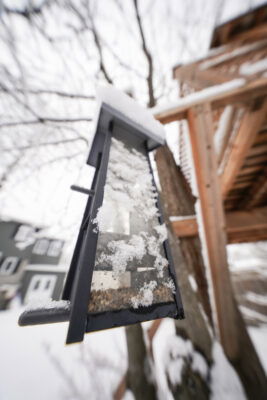
Color and Contrast
As usual with Laowa, colors are rich and punchy. Contrast is always high with these lenses, especially in darker areas, but in recent years the company seems to have produced lenses with more subtle control over colors, for a more neutral look. The outcome is images with true-to-life colors, pleasing contrast, while retaining the company’s signature look.

With more subdued scenes, the lens is capable of delivering subtle color transitions.
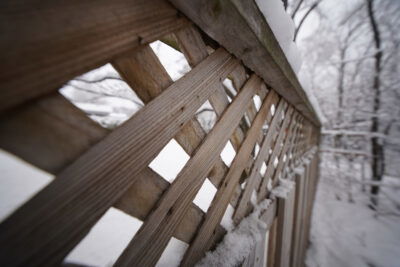
Starbursts
Starbursts are superb. At F2.8 they are absent, but even at F4 the effect is present, with beautifully-shaped lines showing excellent definition. This is a highlight of the lens.



Metering and Exposure
During our tests, exposure was generally consistent and reliable. There was, as often with wide lenses, a small tendency to underexpose, which is a safe bet when unexpected light sources are likely to enter the large field of view.
Sharpness
Sharpness, or a lens’s ability to resolve small details, is far from the only important characteristic of a lens, but it is probably the one which many users look at first. Soft images distract the viewer and the sharpest point in an image draws the eye.
There are several ways to measure resolution. Some are quantitative, such as the number of lines per millimeter that can be resolved, while others are comparative, such as using a standardized scene to pit lenses against one another. We will use the latter, and supplement it with real-life examples below.
To evaluate sharpness, we use a standard test chart that can be used to compare lenses to one another. We place the camera and lenses at a distance of 100x the focal length, so that the chart occupies the same area on all test images. This results in a distance of 1 m in the present case. The chart is positioned successively in the center, on the edge and corner off the frame, testing all apertures each time. Focus is repeated for each position to avoid field curvature contributions.
This test will not show how good a lens can be. Quite the contrary, it is a stress test to illustrate the limits of a lens’s capabilities.
Resolution is of course sensor-relevant. For this test we use the A7C camera’s 24 MP sensor.
Test results at 10mm
The following images illustrate the results at all apertures at 10mm.
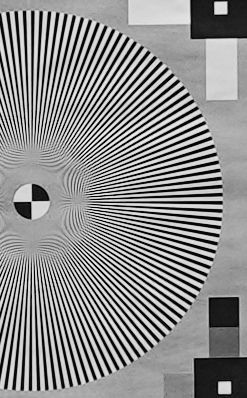

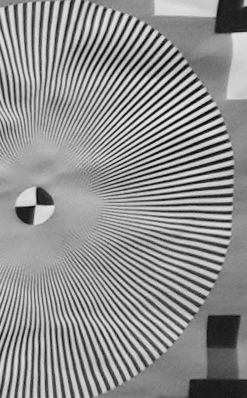


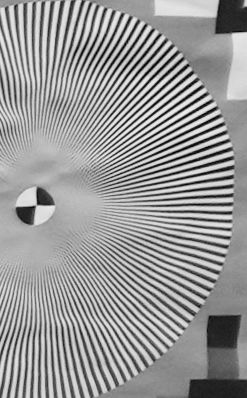

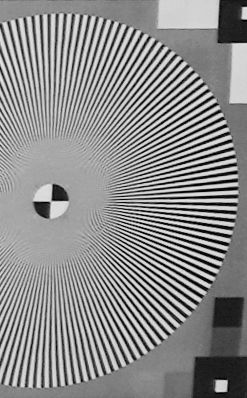
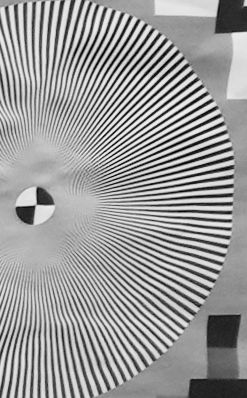
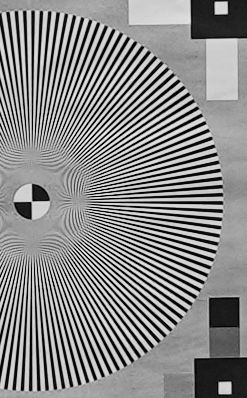
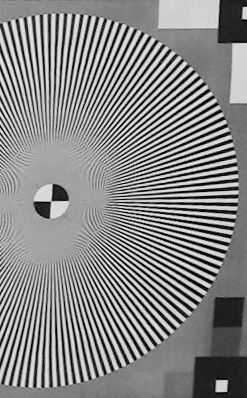
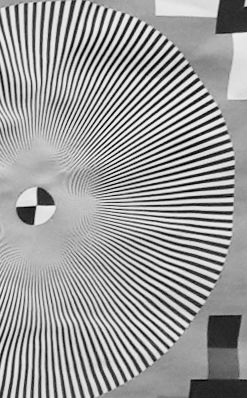

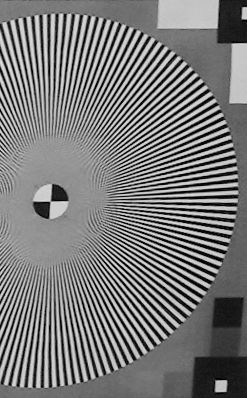
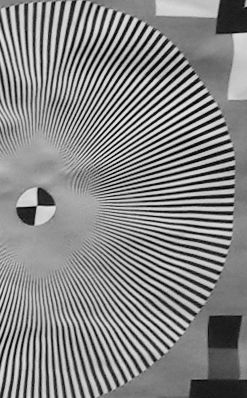

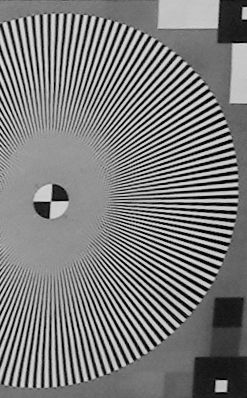
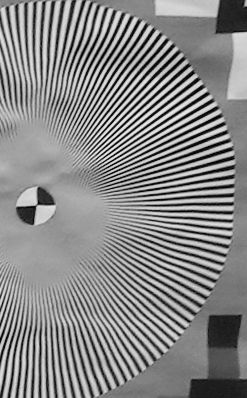
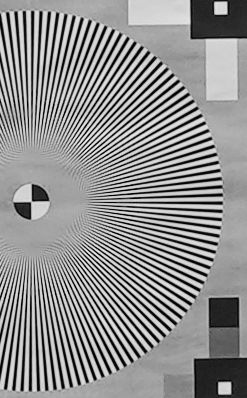


Laowa prime lenses typically offer very good resolution capabilities, and this 10mm does not disappoint.
In the center, even wide open at F2.8, sharpness is excellent. It improves even more at F4 and remains at this level up to F11. F16 shows a moderate decrease in resolution, but remains above expectations. F22 is softer but still usable. This is impressive, and means that for centered subjects, the lens can be used almost regardless of the aperture.
On the edges, results are also good, if not as impressive. At F2.8 and F4, sharpness is adequate, but not as good as the center. Between F5.6 and F11, edges reach their peak. As expected, F16 and F22 are not as good.
Corners are almost a copy-paste of the edges. This is impressive. It shows that the Laowa 10mm will offer good uniformity (desirable for a wide lens) between F5.6 and F11, and some measure of subject isolation at wider apertures.
Summary
The Laowa 10mm is a top performer for center sharpness. It reaches the limits of the A7C’s sensor. Edges and corners are not as impressive, but reach very good levels at medium apertures.
Vignetting
Vignetting, or the darkening of corners at wider apertures, is both a defect and a feature, as it can be used creatively to put emphasis on subjects closer to the center, create a mood or a vintage look. It can also be corrected automatically by modern cameras so is less of a problem than in the past. That is only true for lenses with electronic contacts, including the Laowa 10mm, but sadly the lens does not appear to include a correction profile.
The following chart illustrates the vignetting of the lens for full frame when left uncorrected.

Vignetting with the Laowa 10mm is never particularly impressive. At wider apertures it scores above 2 EV, highly noticeable. By F5.6 it drops to about 1.8, still high, and remains on this plateau at all other aperture values. It will be visible at all times if uncorrected.
The images below show the lens’s vignetting at varying apertures.
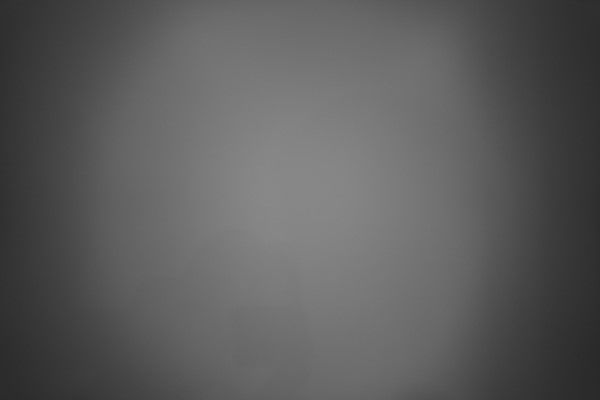
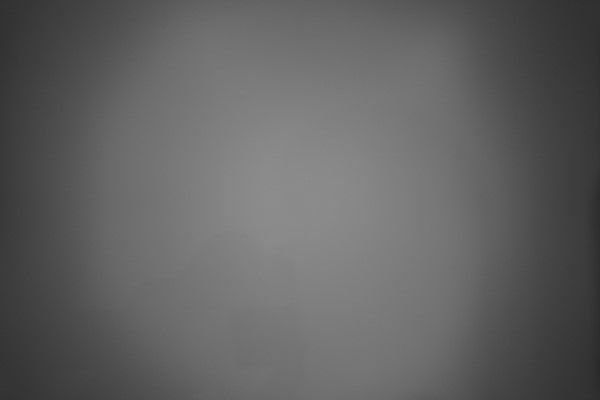

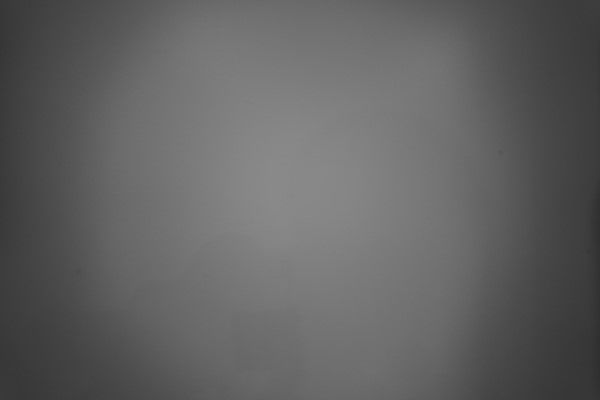
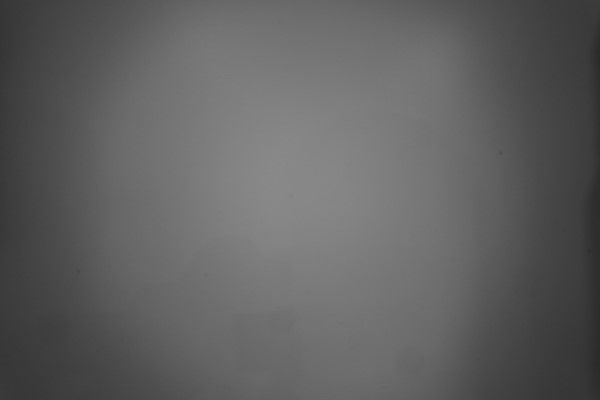

Bokeh
Bokeh is a Japanese term describing the quality of the background blur. It does not relate to the depth of field but to the areas in the image that are beyond the range that is expected to be in focus.
Bokeh is highly subjective. In general, a smooth bokeh with blurred shapes and contours is perceived as being of a higher quality. A shallow depth of field does not always equate a more pleasing bokeh.
To evaluate the characteristics of the background blur, we took pictures at varying apertures, using a scene with a lot of detail and bright highlights. The following images show the results.
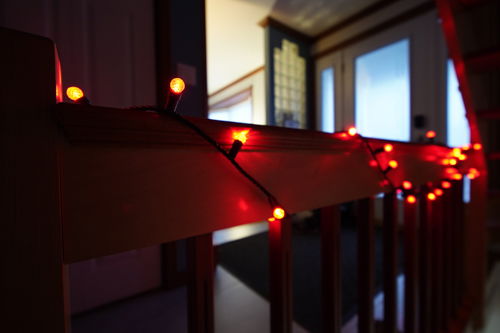


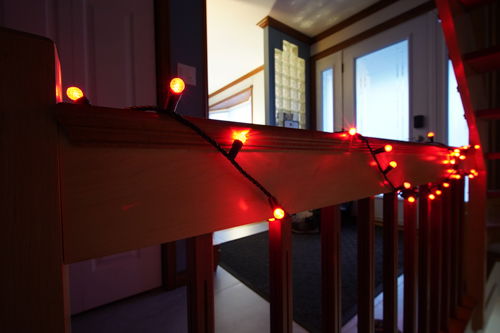
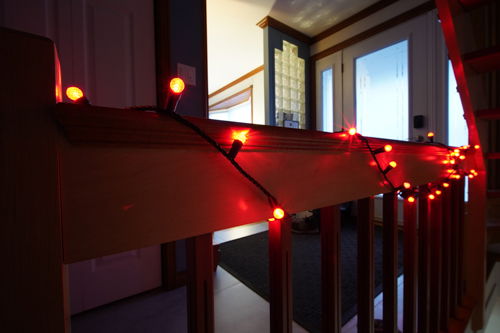
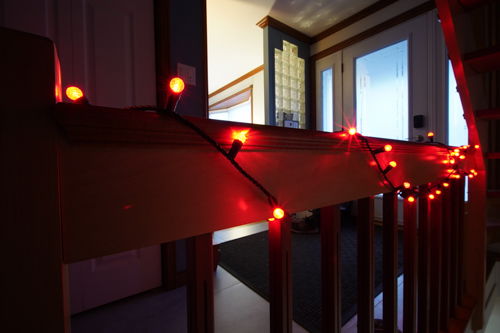

The Laowa 10mm delivers pleasing out-of-focus rendering. One positive aspect is that highlights remain mostly circular, even at smaller apertures and despite the low number of aperture blades (5). The background blur is a bit busy, lacking the smoothness of the best performers, but does not disappoint. Transitions are gradual enough to enhance the rendering.
Flare and Ghosting
Flare is a decrease in contrast caused by reflections on internal lens elements. Ghosting is the appearance of orb-shaped artifacts in an image containing a light source, caused by the same internal reflections. High-quality coatings reduce the importance of flare and ghosting in an image.
We test flare and ghosting by taking pictures of a bright light source positioned at the center and on an edge of the frame, at varying apertures.
Test results at 10mm
With the light in the center, the lens does not show any flare before F16, where a diffuse ring appears far from the light. It is still there at F22, as can be expected. Ghosts are present at F2.8, but thankfully not too distracting. They do not really change up to F8. At F11 other ghosts appear close to the light.
With corner illumination, at F2.8 and F4 a large halo is present far from the light. A few ghosts are also visible. The halo is gone by F5.6, but the ghosts remain and become progressively more defined. This means that previously diffuse ghosts become easier to spot. At F22, things become hectic, with extra ghosts and flare appearing. The beautiful starbursts get deformed with corner illumination, stretching rather intensely.
Chromatic aberration
Chromatic aberration (CA) occurs because different colours do not always have the same focal point. With modern lenses designs, which are better corrected than vintage designs, this is more likely to occur in out-of-focus areas. CA effects are more visible near fast transitions from bright to dark areas.
Most modern cameras have built-in tools to remove CA. Digital manipulations can have an impact on other aspects of an image, thus it is useful to know how a lens performs when those automatic corrections are disabled.
Our test sets up the camera at 45° and focuses on the center of the frame, with targets at the center, top and bottom. Images are captured at varying apertures at 10mm.


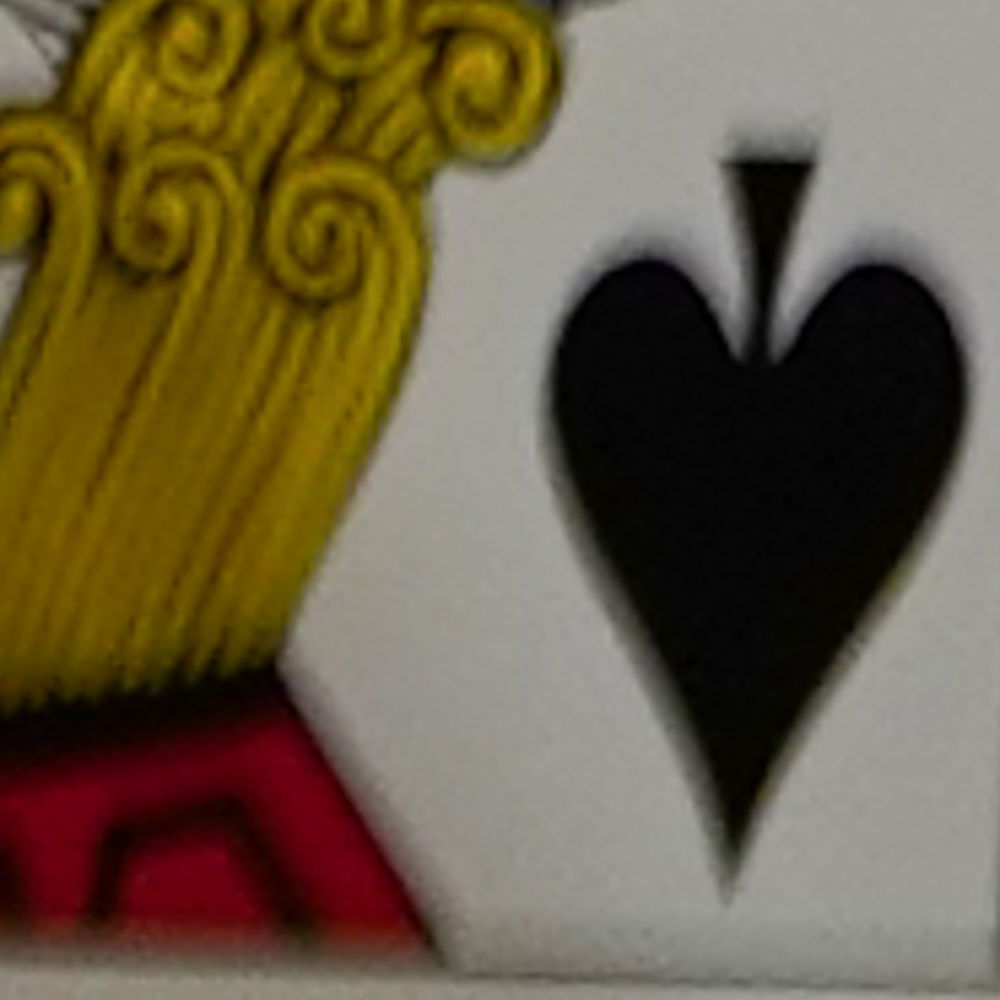

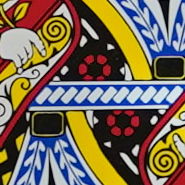
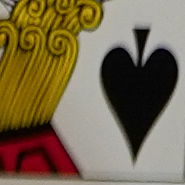

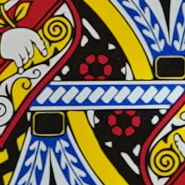

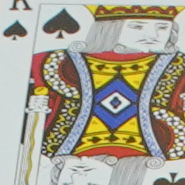
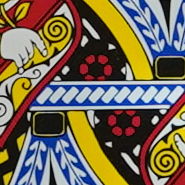
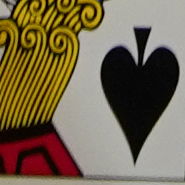

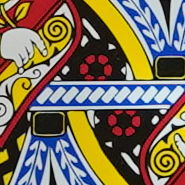


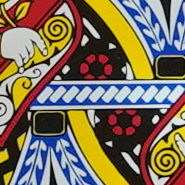

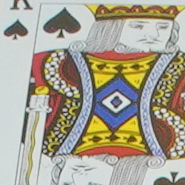
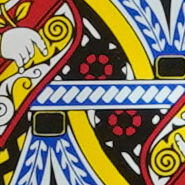
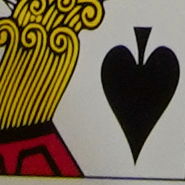
This is an easy topic to cover. The Laowa 10mm shows absolutely no chromatic aberration in our tests. It doesn’t get better than this.
Purple fringing
There were no occurrences of purple fringing in our tests with the Laowa 10mm.
Distortion
Distortion refers to a lens’s ability to represent straight lines as straight lines… Wide angle lenses frequently generate barrel distortion, while longer focal lengths are more likely to cause pincushion distortion.
The Laowa 10mm is a wide angle lens, but also a prime. As such, we expect some effort to be put towards controlling the amount of distortion. It also bears the “Zero-D” label, and Laowa typically takes distortion quite seriously. Lenses with this label are, as a rule, better than their peers.
We use a standard test pattern of straight lines and test at varying focal lengths.
The images below show the uncorrected and corrected distortion figures at various focal lengths.
10mm
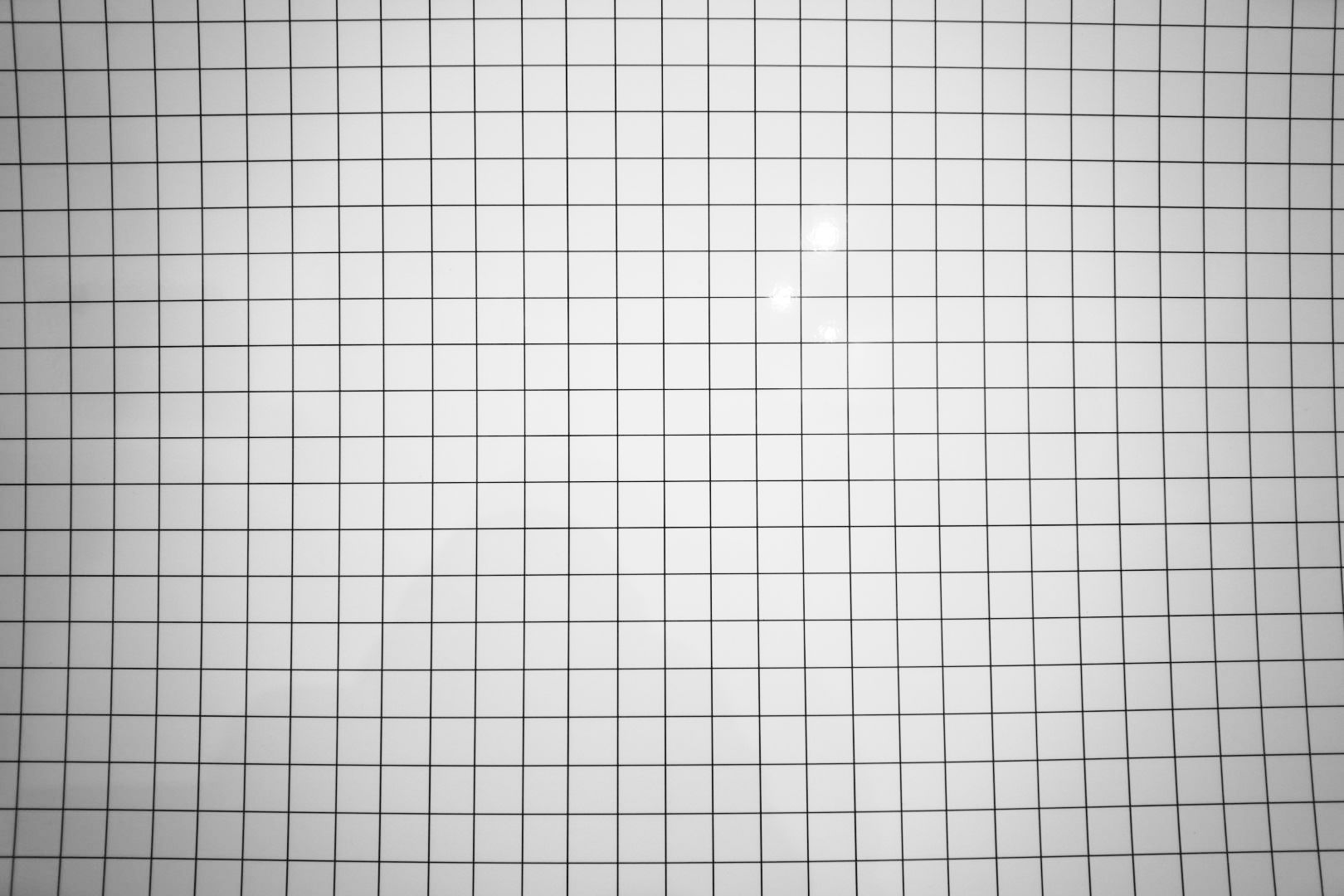

The Laowa 10mm shows 1.3% of barrel distortion. Not overly dramatic, and unlikely to be visible except when straight lines travel near the edges of the frame. As expected, this lens does very well, and many competitors with less ambitious focal lengths offer much worse results. Tilting the lens up or down will enhance the effect, as always.
Activating in-body corrections does not change the output. As mentioned earlier, the lens does not include correction profiles. It is still possible to correct via post-processing.
The image below shows how little impact distortion has in real-life conditions.

Sample images
Here is a gallery of samples images captured with the Laowa 10mm. You can click on individual images for a larger view.





































Conclusion
The Laowa 10mm F2.8 Zero-D AF FF lens is an impressive feat of engineering. With it, Laowa takes an important step forward.
There has never been anything wrong with Laowa lenses in the past. They have always offered excellent build quality, produced great images, and represented a high value. But the elephant in the room has always been the lack of autofocus. Many users don’t care (especially for macro and ultra-wide lenses) but for others, the lack of AF is a show-stopper. For the latter group, this new lenses changes everything.
Build quality is superb, and a clear departure from the usual aesthetics of Laowa lenses. This is probably deliberate: the lens has a modern and sleek look to go with its modern capabilities. The metal body is as high-quality as other Laowa lenses (and is even weather-resistant) but the design cues, finish, color are all different. The lens also has a much large diameter than what we have seen from the company in the past. Despite this, it remains lightweight and moderately compact, and a pleasure to use thanks to the huge focus ring and AF-MF switch.
Optical performances are, mostly, equal or better than expected. In particular, center sharpness is truly impressive. Edges and corners do not disappoint, but lag behind the center. Good uniformity is possible at medium apertures.
Distortion is present, reaching 1.3%. For a 10mm lens, this is excellent. Chromatic aberration is completely absent.
Bokeh and out-of-focus rendering are generally pleasing. Highlights remain mostly circular even at medium and small apertures, transitions are gradual enough. The background can get a bit busy but never distracting. For an ultra-wide lens, the Laowa 10mm does pretty well.
Flare and ghosting are good, not great. Ghosting occurs in most conditions, without being overly distracting. Flare can also occur with the “right” combination of light position and aperture.
Starbursts are splendid. Even at F4, they are present and beautifully shaped, remaining so at all smaller apertures. Only F2.8 lacks the effect, something to be expected.
Vignetting is one of the weakest points of this lens. Regardless of the aperture, it will be present and visible. The lack of automatic corrections means some users will need to correct it via post-processing.
Focusing is certainly a strong point : the lens can compete with the best, both for tracking and for pure AF speed. It does not feel like a first attempt despite being exactly so! Focusing is fast, accurate, tracking works as expected. Congratulations to the manufacturer for making a lens which just works as expected, no more and no less.
With its weather resistant, beautiful metal body, the Laowa 10mm is both rugged and nice-looking. It is also unique, being the widest rectilinear full frame prime lens available. To find an ultra-wide AF lens, users have to move to 14mm or select this Laowa. The lens even includes close focusing capabilities. With an aggressive price point of $799, the Laowa 10mm F2.8 Zero-D AF FF should be on the short list of anyone interested in ultra-wide photography.
Pros
- Light, solid and weather resistant
- Unique combination of features (10mm, F2.8, AF, weather resistant, close focusing)
- Beautiful body with elegant touches and AF-MF switch
- Stellar sharpness in the center at all apertures, good uniformity at medium apertures
- No hint of CA or PF
- Reliable and fast AF tracking, extremely fast static AF in good light
- Impressive control over distortion
- Beautiful starbursts starting as low as F4
- Fair price
Cons
- Vignetting is rather extreme
- Average flare performances
- No built-in correction profiles
Before You Go
Do you already own this lens? Are you curious about it? If you do, we’d love to hear your thoughts in the comments below.













Leave a Reply